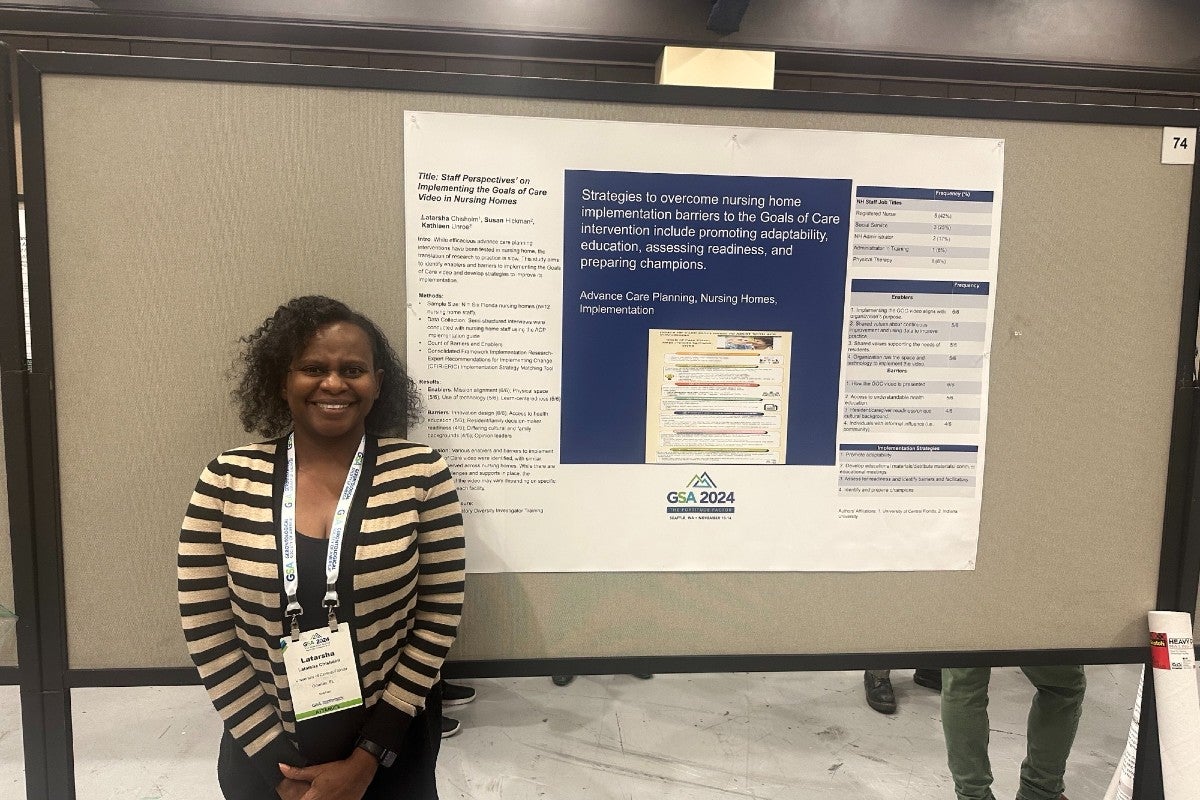Dementia not only affects cognitive and functional abilities, but it’s also among the country’s leading causes of death. When dementia patients are not transitioned into end-of-life care in a timely manner, the delay can cause unnecessary pain, distress and confusion for both them and their loved ones — an issue Latarsha Chisholm works to help alleviate.
Challenges With Quality of Care
Chisholm, an associate professor in the College of Community Innovation and Education’s School of Global Health Management and Informatics, studies nursing home residents living with advanced dementia. She says many facilities struggle to identify the right end-of-life-care transition time due to lack of resources caused by differences in reimbursement.
“The way nursing homes are reimbursed creates a two-tiered system,” Chisholm says. “You have nursing homes paid for privately or through Medicare, where the reimbursement is higher, and nursing homes with mostly Medicaid residents, where the reimbursement is lower. When you have this difference in reimbursements, you have differences in resources available to facilities, which creates imbalances in quality of care.”
But there’s also another issue at hand — a lack of discussions taking place about hospice options. Chisholm says these conversations can be challenging for patients, families and nursing home staff alike.
“We don’t like to talk about death, even though it’s going to happen to all of us,” Chisholm says. “Staff may not feel knowledgeable enough to have these discussions, and patients and their families may have … religious [beliefs or perspectives based on their backgrounds] that make them uncomfortable with the subject.”
While these conversations may be difficult, they are important. Chisholm says patients who never express their wishes for end-of-life care leave those big decisions to their families and care providers.
“Many patients with advanced dementia can no longer speak for themselves, and family members are usually proxies to discuss their care needs,” Chisholm says. “When you’re no longer able to speak for yourself and you haven’t expressed your wishes, your family can only assume what you want. You could end up receiving unnecessary care that neither improves your quality of life nor helps you live longer.”

Resources for Support, Communication and Planning
Inspired to foster this critical dialogue and help prepare dementia patients for a smoother transition, Chisholm and a cross-collaborative team are working with nursing homes to establish a standardized process for determining when to transition residents into hospice. Through a series of stakeholder interviews, the team proposed using the Mitchell Index — a data-collecting tool that calculates the mortality risk of dementia patients — to predict which residents have the greatest need for advanced-care planning conversations, helping staff give those residents a timely opportunity to discuss their desires.
Chisholm says the care providers the team has worked with have responded positively, indicating that the Mitchell Index could be successfully adapted for use in long-term care settings. Now, they need a tool to help promote and facilitate end-of-life-care planning conversations — and that’s where her research comes in.
“One nursing home found that the Mitchell Index facilitated their need to have discussions about advanced-care planning, and they want more information on how to do that,” Chisholm says. “Our next step is to link the Mitchell Index study with my research, which talks about promoting goals-of-care discussions. Combining these two will create a full picture and help us give people a more comfortable, respectful death.”
Going forward, Chisholm says the goal of her research is to improve the quality of care for all nursing home residents.
“In the last 10 to 20 years, we’ve seen a shift in nursing homes from hospital-like care to more of a home-like environment,” Chisholm says. “I love this move toward person-centered care — really trying to understand who the resident is, listening to them, and focusing not just on their physical needs but on their overall well-being. Nursing homes often get a bad rap, and there’s a lot we can do to improve both the quality of care and how people perceive them.”





